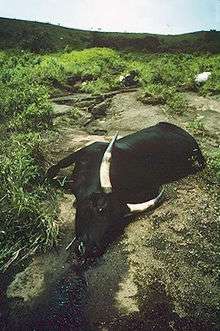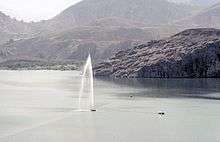Lake Nyos disaster

The Lake Nyos disaster occurred on 21 August 1986, when a limnic eruption at Lake Nyos, in northwestern Cameroon, produced a large cloud of carbon dioxide (CO2), which descended onto nearby villages, killing 1,700 people and 3,500 livestock.
The eruption triggered the sudden release of about 100,000–300,000 tons[1] (some sources state as much as 1.6 million tons)[2] of CO2. This gas cloud rose at nearly 100 kilometres per hour (62 mph) and[3] spilled over the northern lip of the lake. It then rushed down two valleys, branching off to the north, displacing all the air and suffocating people and livestock within 25 kilometres (16 mi) of the lake.[4]
A degassing system has since been installed at the lake, with the aim of reducing the concentration of CO2 in deep waters and therefore the risk of further eruptions.
Eruption and gas cloud
It is not known what triggered the catastrophic outgassing. Most geologists suspect a landslide, but some believe that a small volcanic eruption may have occurred on the bed of the lake. A third possibility is that cool rainwater falling on one side of the lake triggered the overturn. Others still believe there was a small earthquake, but as witnesses did not report feeling any tremors on the morning of the disaster, this hypothesis is unlikely. Whatever the cause, the event resulted in the rapid mixing of the supersaturated deep water with the upper layers of the lake, where the reduced pressure allowed the stored CO2 to effervesce out of solution.
It is believed that about 1.2 cubic kilometres (0.29 cu mi) of gas was released.[5] The normally blue waters of the lake turned a deep red after the outgassing, due to iron-rich water from the deep rising to the surface and being oxidised by the air. The level of the lake dropped by about a metre and trees near the lake were knocked down.
Scientists concluded from evidence that a 100 m (330 ft) column of water and foam formed at the surface of the lake, spawning a wave of at least 25 metres (82 ft) that swept the shore on one side.[6]
Carbon dioxide, being about 1.5 times denser than air, caused the cloud to "hug" the ground and descend down the valleys, where various villages were located. The mass was about 50 metres (160 ft) thick, and travelled downward at a speed of 20–50 kilometres per hour (12–31 mph). For roughly 23 kilometres (14 mi), the gas cloud was concentrated enough to suffocate many people in their sleep in the villages of Nyos, Kam, Cha, and Subum.[3] About 4,000 inhabitants fled the area, and many of these developed respiratory problems, lesions, and paralysis as a result of the gas cloud.[7]
Effects on survivors

One survivor, Joseph Nkwain from Subum, described himself when he awoke after the gases had struck:
"I could not speak. I became unconscious. I could not open my mouth because then I smelled something terrible . . . I heard my daughter snoring in a terrible way, very abnormal . . . When crossing to my daughter's bed . . . I collapsed and fell. I was there till nine o'clock in the (Friday) morning . . . until a friend of mine came and knocked at my door . . . I was surprised to see that my trousers were red, had some stains like honey. I saw some . . . starchy mess on my body. My arms had some wounds . . . I didn't really know how I got these wounds . . . I opened the door . . . I wanted to speak, my breath would not come out . . . My daughter was already dead . . . I went into my daughter's bed, thinking that she was still sleeping. I slept till it was 4:30 p.m. in the afternoon . . . on Friday. (Then) I managed to go over to my neighbors' houses. They were all dead . . . I decided to leave . . . (because) most of my family was in Wum . . . I got my motorcycle . . . A friend whose father had died left with me (for) Wum . . . As I rode . . . through Nyos I didn't see any sign of any living thing . . . (When I got to Wum), I was unable to walk, even to talk . . . my body was completely weak."[3][8]
Following the eruption, many survivors were treated at the main hospital in Yaoundé, the country's capital. It was believed that many of the victims had been poisoned by a mixture of gases that included hydrogen and sulfur. Poisoning by these gases would lead to burning pains in the eyes and nose, coughing and signs of asphyxiation similar to being strangled.[9]
Aftermath

The scale of the disaster led to much study on how a recurrence could be prevented.[10] Several researchers proposed the installation of degassing columns from rafts in the middle of the lake. The principle is to slowly vent the CO2 by lifting heavily saturated water from the bottom of the lake through a pipe, initially by using a pump, but only until the release of gas inside the pipe naturally lifts the column of effervescing water, making the process self-sustaining.[11]
Starting from 1995, feasibility studies were successfully conducted, and the first permanent degassing tube was installed at Lake Nyos in 2001. Two additional pipes were installed in 2011[12][13]
Following the Lake Nyos disaster, scientists investigated other African lakes to see if a similar phenomenon could happen elsewhere. Lake Kivu in the Democratic Republic of Congo, 2,000 times larger than Lake Nyos, was also found to be supersaturated, and geologists found evidence of outgassing events around the lake happened about every thousand years.
References
- ↑ "Can We Bury Global Warming? (2005)". Scientific American. July 2005. Retrieved December 14, 2012.
- ↑ Mathew Fomine, Forka Leypey (2011). "The Strange Lake Nyos CO2 Gas Disaster". Australasian Journal of Disaster and Trauma Studies. Massey University. 2011-1. ISSN 1174-4707. Retrieved February 4, 2016.
- 1 2 3 "Lake Nyos (1986)". San Diego State University. March 31, 2006. Retrieved December 19, 2008.
- ↑ Smolowe, Jill (September 8, 1986). "Cameroon the Lake of Death". TIME. 128 (10): 34–37. Archived from the original on February 27, 2009. Retrieved December 9, 2013.
- ↑ "The Strangest Disaster of the 20th Century". Neatorama. May 21, 2007. Retrieved June 20, 2010.
- ↑ David Brown (February 1, 2000). "Scientists hope to quiet Cameroon's killer lakes". The Washington Post. Retrieved December 19, 2008.
- ↑ Lake Nyos disaster, Cameroon, 1986: the medical effects of large scale emission of carbon dioxide?, BMJ, Volume 298, May 27, 1989,
- ↑ A. Scarth. USGS, 1999.
- ↑ BBC contributors (August 21, 1986). "21 August: 1986: Hundreds gassed in Cameroon lake disaster". BBC. Retrieved December 19, 2008.
- ↑ Kling, G. W.; Evans, W. C.; Tanyileke, G.; Kusakabe, M.; Ohba, T.; Yoshida, Y.; Hell, J. V. (2005). "Degassing Lakes Nyos and Monoun: Defusing certain disaster". Proceedings of the National Academy of Sciences. 102 (40): 14185. doi:10.1073/pnas.0502274102.
- ↑ Degassing Lake Nyos project http://pagesperso-orange.fr/mhalb/nyos/nyos.htm
- ↑ Degassing the "Killer Lakes" Expedition 2001
- ↑ "Science Actualités – Ressources – Cité des sciences et de l'industrie – Expositions, conférences, cinémas, activités culturelles et sorties touristiques pour les enfants, les parents, les familles – Paris". Universcience.fr. Archived from the original on January 3, 2012. Retrieved October 17, 2012.